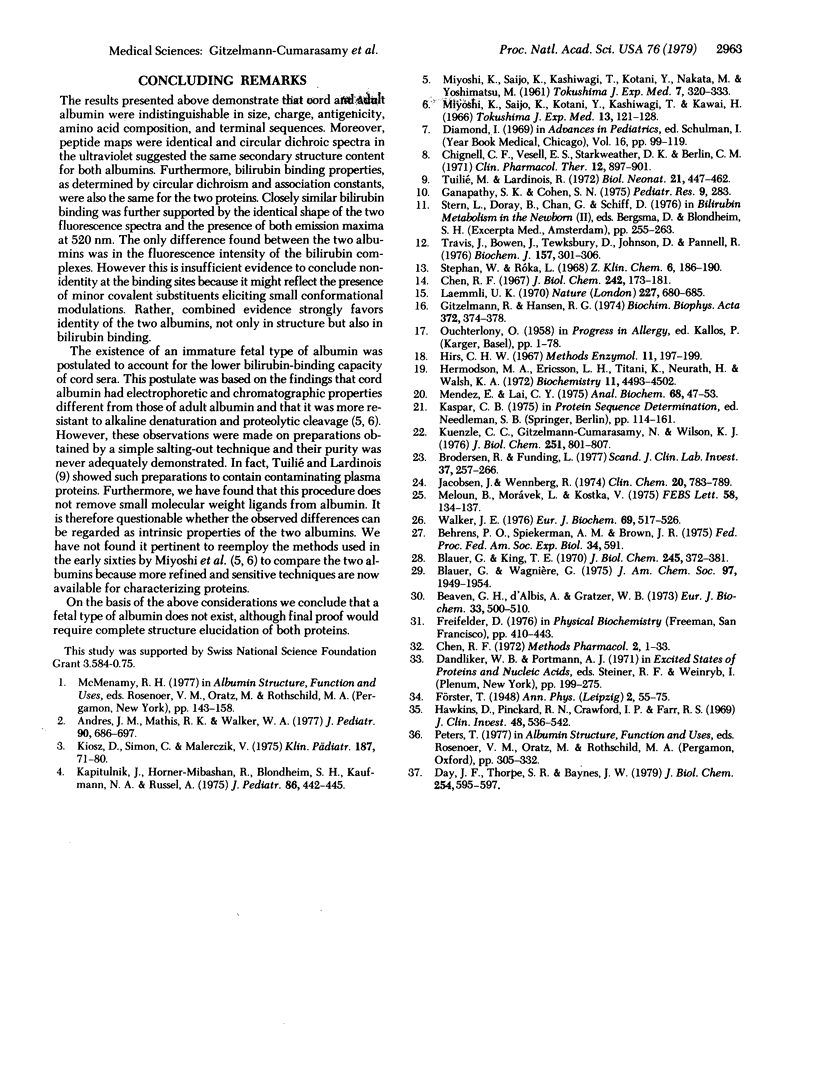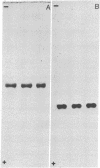Abstract
The existence of a functionally immature fetal albumin has been postulated to explain the reduced ability of newborn plasma to bind bilirubin and various drugs. In support of this, cord and adult albumin, isolated by a simple salting-out technique, were reported to differ in electrophoretic and chromatographic properties and in their resistance to alkali and proteolytic enzymes. However, the interpretation of these findings has since been questioned. To resolve this controversy, we have purified to homogeneity human serum albumins from pooled umbilical cord and adult donor plasma. The two albumins were compared and found to be indistinguishable by polyacrylamide gel electrophoresis with and without sodium dodecyl sulfate, as well as by immunoelectrophoresis and double immunodiffusion using specific antibodies against both albumins. Furthermore, the amino acid compositions, the aminoterminal sequence (Asp-Ala-His-Lys-Ser-Glu-Val-Ala-), the carboxy terminus (Leu), and the peptide fingerprints were identical in the two albumins. No significant differences were found by circular dichroism in the ultraviolet (200-350 nm). Binding studies with bilirubin showed association constants of 3.7 ± 0.7 × 107 M-1 for cord and 2.9 ± 0.3 × 107 M-1 for adult albumin, respectively. The circular dichroic spectra of 1:1 bilirubin·albumin complexes showed considerable variation between the batches but were not significantly different. The only difference was found in the fluorescence spectra of the bilirubin·albumin complexes, in which complexes with adult albumin showed only 75% of the relative fluorescence exhibited with cord albumin. The combined results nevertheless strongly indicate that fetal and adult albumins are very similar, if not identical.
Keywords: neonatal medicine, bilirubin binding, immunochemistry, protein structure, spectroscopy
Full text
PDF



Images in this article
Selected References
These references are in PubMed. This may not be the complete list of references from this article.
- Andres J. M., Mathis R. K., Walker W. A. Liver disease in infants. Part I: Developmental hepatology and mechanisms of liver dysfunction. J Pediatr. 1977 May;90(5):686–697. doi: 10.1016/s0022-3476(77)81229-8. [DOI] [PubMed] [Google Scholar]
- Blauer G., King T. E. Interactions of bilirubin with bovine serum albumin in aqueous solution. J Biol Chem. 1970 Jan 25;245(2):372–381. [PubMed] [Google Scholar]
- Blauer G., Wagnière G. Conformation of bilirubin and biliverdin in their complexes with serum albumin. J Am Chem Soc. 1975 Apr 2;97(7):1949–1954. doi: 10.1021/ja00840a057. [DOI] [PubMed] [Google Scholar]
- Breaven G. H., D'Albis A., Gratzer W. B. The interaction of bilirubin with human serum albumin. Eur J Biochem. 1973 Mar 15;33(3):500–509. doi: 10.1111/j.1432-1033.1973.tb02709.x. [DOI] [PubMed] [Google Scholar]
- Brodersen R., Funding L. Binding of bilirubin and long-chain fatty acids to human serum albumin with general remarks on displacement of firmly bound ligands. Scand J Clin Lab Invest. 1977 May;37(3):257–266. doi: 10.1080/00365517709091491. [DOI] [PubMed] [Google Scholar]
- Chen R. F. Removal of fatty acids from serum albumin by charcoal treatment. J Biol Chem. 1967 Jan 25;242(2):173–181. [PubMed] [Google Scholar]
- Chignell C. F., Vesell E. S., Starkweather D. K., Berlin C. M. The binding of sulfaphenazole to fetal, neonatal, and adult human plasma albumin. Clin Pharmacol Ther. 1971 Nov-Dec;12(6):897–901. doi: 10.1002/cpt1971126897. [DOI] [PubMed] [Google Scholar]
- Day J. F., Thorpe S. R., Baynes J. W. Nonenzymatically glucosylated albumin. In vitro preparation and isolation from normal human serum. J Biol Chem. 1979 Feb 10;254(3):595–597. [PubMed] [Google Scholar]
- Diamond I. Bilirubin binding and kernicterus. Adv Pediatr. 1969;16:99–119. [PubMed] [Google Scholar]
- Hawkins D., Pinckard R. N., Crawford I. P., Farr R. S. Structural changes in human serum albumin induced by ingestion of acetylsalicylic acid. J Clin Invest. 1969 Mar;48(3):536–542. doi: 10.1172/JCI106011. [DOI] [PMC free article] [PubMed] [Google Scholar]
- Hermodson M. A., Ericsson L. H., Titani K., Neurath H., Walsh K. A. Application of sequenator analyses to the study of proteins. Biochemistry. 1972 Nov 21;11(24):4493–4502. doi: 10.1021/bi00774a011. [DOI] [PubMed] [Google Scholar]
- Jacobsen J., Wennberg R. P. Determination of unbound bilirubin in the serum of newborns. Clin Chem. 1974 Jul;20(7):783–783. [PubMed] [Google Scholar]
- Kapitulnik J., Horner-Mibashan R., Blondheim S. H., Kaufmann N. A., Russell A. Increase in bilirubin-binding affinity of serum with age of infant. J Pediatr. 1975 Mar;86(3):442–445. doi: 10.1016/s0022-3476(75)80982-6. [DOI] [PubMed] [Google Scholar]
- Kiosz D., Simon C., Malerczyk V. Die Plasmaeiweissbindung von Clindamycin, Cephazolin und Cephradin bei Neugeborenen und Erwachsenen. Klin Padiatr. 1975 Jan;187(1):71–80. [PubMed] [Google Scholar]
- Kuenzle C. C., Gitzelmann-Cumarasamy N., Wilson K. J. Affinity labeling of the primary bilirubin binding site of human serum albumin. J Biol Chem. 1976 Feb 10;251(3):801–807. [PubMed] [Google Scholar]
- Laemmli U. K. Cleavage of structural proteins during the assembly of the head of bacteriophage T4. Nature. 1970 Aug 15;227(5259):680–685. doi: 10.1038/227680a0. [DOI] [PubMed] [Google Scholar]
- Meloun B., Morávek L., Kostka V. Complete amino acid sequence of human serum albumin. FEBS Lett. 1975 Oct 15;58(1):134–137. doi: 10.1016/0014-5793(75)80242-0. [DOI] [PubMed] [Google Scholar]
- Mendez E., Lai C. Y. Regeneration of amino acids from thiazolinones formed in the Edman degradation. Anal Biochem. 1975 Sep;68(1):47–53. doi: 10.1016/0003-2697(75)90677-6. [DOI] [PubMed] [Google Scholar]
- Miyoshi K., Saijo K., Kotani Y., Kashiwagi T., Kawai H. Characteristic properties of fetal human albumin (Alb F) in isomerization equilibrium. Tokushima J Exp Med. 1966 Nov;13(3-4):121–128. [PubMed] [Google Scholar]
- OUCHTERLONY O. Diffusion-in-gel methods for immunological analysis. Prog Allergy. 1958;5:1–78. [PubMed] [Google Scholar]
- Stephan W., Róka L. Adsorption von Lipoproteiden. Behandlung von Seren mit Adsorbentien. I. Z Klin Chem Klin Biochem. 1968 May;6(3):186–190. [PubMed] [Google Scholar]
- Travis J., Bowen J., Tewksbury D., Johnson D., Pannell R. Isolation of albumin from whole human plasma and fractionation of albumin-depleted plasma. Biochem J. 1976 Aug 1;157(2):301–306. doi: 10.1042/bj1570301. [DOI] [PMC free article] [PubMed] [Google Scholar]
- Tuilié M., Lardinois R. The binding of unconjugated bilirubin by human sera and purified albumins. Biol Neonate. 1972;21(5):447–462. doi: 10.1159/000240531. [DOI] [PubMed] [Google Scholar]
- Wendelschafer-Crabb G., Erlandsen S. L., Walker D. H. Ultrastructural localization of viral antigens using the unlabeled antibody-enzyme method. J Histochem Cytochem. 1976 Mar;24(3):517–526. doi: 10.1177/24.3.57192. [DOI] [PubMed] [Google Scholar]







